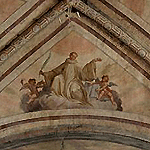

The spectacular frescos hidden in old Abbazia.
 Museum hours: 9:00 - 11:45 and 15:00 - 18:45
Museum hours: 9:00 - 11:45 and 15:00 - 18:45
 Duration: 1 - 2 hours
Duration: 1 - 2 hours
 Availability: Tue - Sun. Mon. closed
Availability: Tue - Sun. Mon. closed
 Meeting time: on request
Meeting time: on request
In the close neighborhood of Milan, about 3 kilometers south-east of Porta Romana the one of the most picturesque
Cistercian monasteries in Italy dominates above its surrounding meadows: Abbazia di Chiaravalle.
The Abbazia di Chiaravalle was founded in 1135 by St. Bernard, abbot de Clairvaux and his monks. Not much survived from St. Bernard original structure.
Saint Bernard was born probably in 1090 of Burgundian landowning aristocracy. He grew up in an atmosphere of deep religious respect for mercy, justice and loyalty.
In 1118formerly he convinced his four
brothers, uncle and another 25 men to establish a monastery devoted to Virgin Mary, the Queen of
Heaven at Clairvaux on the Borders of Burgundy and Champagne (today France). in 1128 he traced the outlines of the Rules of the Knights Templars,
who soon became the ideal of the French nobility.
In 1130 th schism broke out in the Church by election of two popes Innocent II and Anacletus II. Innocent II was banished from Rome and took the refuge in France.
Louis de Gros, king of France, called national council of the bishops at Etampes.
Here, on the French ground Bernard, who was chosen by council to judge between the rival popes, met Innocent II.
He decided in favor of Innocent II and went with him to Italy. In Italy he hidden himself for a shot time in Abbazia di Chiaravalle on the outskirts of Milan,
where he devoted himself to the composition of pious works, which have
won him the title of ”Doctor of the Church.”
Today's church built on the site of St. Bernard original cloister was erected between 1172-1221, several years after St. Bernard death. But how the French monk
The body of the church and cloister splendidly incorporate the
charming local Lombard Romanesque style with elements of monumental French Gothic architecture.
During the building of their new home Cistercian monks turned the waste land, formerly under the water, into cultivated fields where they
grows new crops and plants unknown to local peasants. Unbelievably created several centuries ago surrounded the abbey landscape
has remained virtually unchanged until our time.
Build of local building material, bricks and white stone, this once vital religious and artistic center today makes a splendid impression, with its
austere architectural form, out of which rises the 14th century tower.
The splendid octagonal bell-tower called øCirabiciaccola” build between 1347 - 1349, made of red brick and white stone arches,
gives the ascetic religious complex unforgettable lively appearance.
The church and cloister are particularly worth of visiting.
The late Romanesque portal made of white stone leads us to the three-nave interior of the church,
The harmonic proportion of light and silence of the church gives it a transcendental, almost mystical atmosphere.
The amazingly beautiful, nearly all covered in frescos interior of the church bear the evidence of the prestige, religious
and cultural importance of the abby over the centuries.
The frescos showing scenes from life of
Virgin painted by unknown Lombard 14th century masters on octagonal copula are considered to be most impressive 14th century frescos in Northern Italy.
They bear clear influence by Giotto and Siena school
The marvelous Renaissance frescos by Bernardo Luini (Madonna and a Child, 1512), the Campi brothers (The Crucifiction of Jesus Christ) and Angiolo
Everardi and Giovanni Mauro della Rovere
brothers known also under name
”Fiamminghini” (Genealogical tree of Cistercian brothers, 1613) are considered to be one of the most beautiful high Renaissance and early Baroc frescos in Milan.
The impressive wooden choir was craved several years later (around 1645) by Carlo Garavaglia.
The end of the abbazia prosperity came in 1798 when the abbazia was abandoned. As a result the part of the cloister and house buildings were demolished in 1862. In 1952 the abbazia was returned to Cistercians.
Today, it is
home to a community of Cistercian order who dedicate
themselves to the restoration of the church, ancient books and codes.
Want to learn more about hidden frescos in old abbazia, join one of our tours.
Previous tour: The San Siro Stadium
Next tour: The Last Supper
